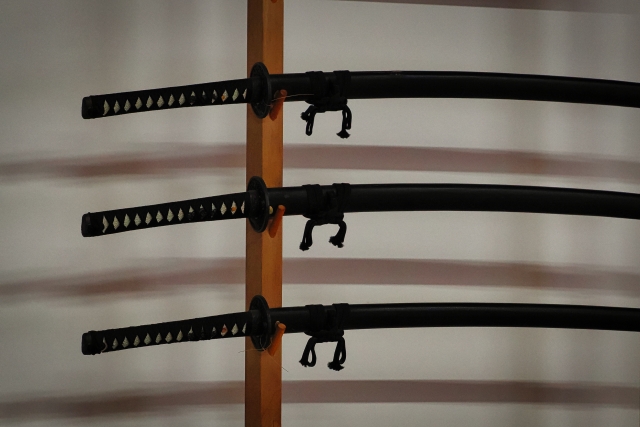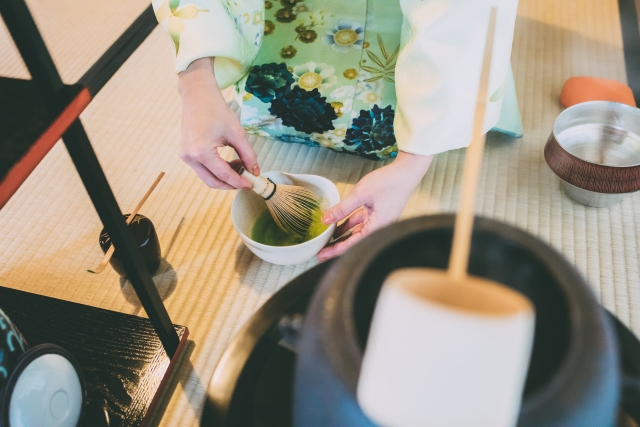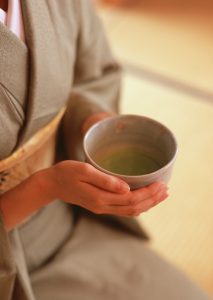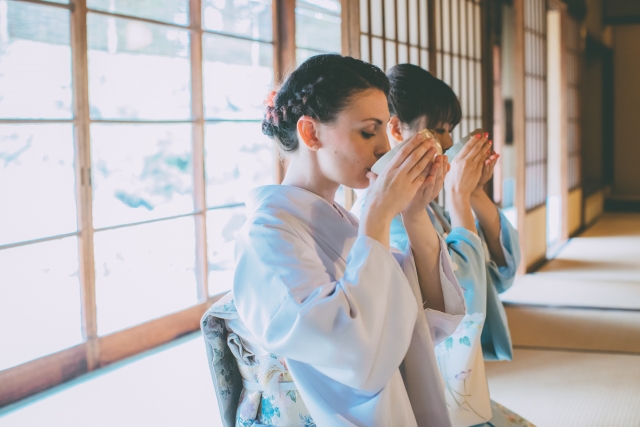
Knowing these fundamental rules will make your experience of any tea ceremonies you participate much more exciting and interesting♪
If it was a soccer game, there are some basic rules that you won’t enjoy it at all if you didn’t know at all.
For example, 1 team is consisted in 11 members, put a ball into the goal without using hands, so on.
As same as it, tea ceremony has some rules that make it more enjoyable experience if you know them!
If you read this article once, you will be able to easily join tea ceremonies which are held on your travel and events♪
In this article, we’ll show you minimum rules you should to know before you participate Tea Ceremony.
They are very basic rules and may be they will be applied to tea parties of any branches!
(Please follow the host of tea ceremony you attended, as to more fine rules.)
<CONTENTS>:
1.Every guests have their own roles! お正客【O-SYOUKYAKU(main guest)】is very important.
2.A small garden to the Tea room called 露地【ROJI】has so many secrets to reach another world !
3. Finally,お茶会【O-CHAKAI】has started! The theme of that tea ceremony is written on a scroll.
4. How to eat sweets and drink 抹茶【MATCHA】?Why do people turn around a tea bowl??
5. おしまい【OHIMAI(Ending Greeting)】and 拝見【HAIKEN(Appreciating tools)】
1.Every guests have their own roles! お正客【O-SYOUKYAKU(main guest)】is very important especially.
At tea ceremony, each guest have their particular role and the order of entering tea room is also predetermined.

① お正客様【O-SHYOUKYAKU-SAMA】/主客【SHU-KYAKU】A main guest, most important.
② 次客【JI-KYAKU】Next Guest to enter next time.
③ 三客【SAN-KYAKU】Third Guest to enter third.
④ 四客【YON-KYAKU】Fourth Guest to enter fourth.
・・・(depend on number of people who join that tea ceremony.)
⑤ お詰め【O-TSUME】/末客【MAT-KYAKU】The Last Guest who enter a tea room at last.
① お正客様【O-SHOUKYAKU-SAMA】/主客【SHUKYAKU】
The main guest:At the first time, you have to decide who is the 正客【SYOUKYAKU】, the main guest. The main guest is the most important, entering a tea room first order, sitting nearest place to an alcove. 抹茶【MATCHA】for the main guest is served by 主茶碗【OMO-Z(C)YAWAN】 the most important tea bowl in that tea ceremony, and his/her Matcha would be made by 点前【TEMAE】in front of guests
(as for other guest’s tea, except next guest and main guest, are made at tea room’s kitchen called 水屋【MIZUYA】, so it’s way is called 蔭点て【KAGE-DATE(shaow made)】).

And only SYOUKYAKU can talk with the host. Yes, other guests are not allowed to talk in a tea room(!) It is unequal, but for keeping the ordered system and establish a silence of the tea room. So, the person who is the most knowledgeable to the way of tea, having longest experiences person like a teacher or instructor is recommended for SHOUKYAKU.
In some case it is determined, but in 大寄せ【OOYOSE】; Tea Ceremony many unknown people are gathered, you might determine in that time. Usually, it takes about several minutes to decide who become SYOUKYAKU(^▽^;)
▶What’s 茶会【CHAKAI(Tea party) of 大寄せ【OO-YOSE(Large-gathering)】?
② 次客【JIKYAKU】The next guest:
次客【JIKYAKU】, the next guest is a who enter a tea room second.
The next guest’s 抹茶【MATCHA】 is served in the second most important bowl (for example, bowl which has some theme or having seasonal pattern, so on).

Bowls of 抹茶【MATCHA】for main guest and next guest are made by host in a way which had not been changed for some hundred years called お点前【O-TEMAE】, in front of the guests. And MATCHA for third, fourth and after that are served from 水屋【MIZUYA(kind of kitchen of tea room) one after another and it is called 陰点て【KAGE-DATE(shade-made)】.
Therefore, the next guest’s MATCHA will be served after the third guest often, so don’t panic as you think “Am I forgotten ?” (It is often happens in tea parties actually☆)
③ 三客【SAN-KYAKU(Third. Guest)】
④ 四客【YON-KYAKU(Fourth. Guest)….
As their name suggest, they are third and fourth guests to enter the tea room. If you were not used to tea ceremony, it is recommended to enter this area because you can look and follow persons in front of you.
抹茶【MATCHA】for those guests are served in tea bowls called 数茶碗【KAZU-Z(C)YAWAN(number tea bowls)】which have the same designs.

⑤ お詰め/末客【O-tsume/Ma-kkyaku(The Last Guest)】:
お詰め/末客【O-tsume/Ma-kkyaku】is the guest to enter the tea room at last.
He or she has roles like closing the door or return a empty tray of sweets to the host, so on. So, as same as the main guest, the last guest would be the person who is used to tea ceremonies.
▶How different お茶事【O-CHAJI】and お茶会【O-CHAKAI】?
At a tea party where a large number of unspecified people gather,
in order to decide who is the official guest, we often spend for a while exchanging things like, “Please go first,” “No, I’m not you,” and “You’re welcome, please go ahead.” so on. It happens much !(lol)
At GOLDFISH CHAFE’s tea ceremonies, the main guest is often
decided by playing rock, paper, scissors (lol)
If it’s your first time or you’re not used to tea ceremony, it’s recommended that to have a seat of third or fourth, not first nor last.
So, you can imitate those around you (lol)
(However, if you were first-timer, young, or male, it’s rale and might be very welcomed . Then, someone might say “Please become main guest (SHOKU-KYAKU)” .
In that case, I think it would be a good experience to accept with saying something like, “I don’t know anything though, please teach me”, so on.)
2.A small garden to the tea room has so many secrets ! Let’s see it together.
From 此岸【SHIGAN(this shore)】to 彼岸【HIGAN(That shore)—
That is a small trip from our usual stressful world to the perfect Nirvana.

When it comes to Tea Ceremony, the place where we live and having much stress or ambivalence is called 此岸【SHIGAN】, literally means “This Shore”.
And the world in tea room is called 彼岸【HIGAN】That Shore, perfect place like a Nirvana.

From our stressful place to enter the tea room as perfect place, there are a lot of points at tea garden.
The path to a tea room is, even it is in the middle of large city, build like it is in the deep mountain or valley .
For that, even it is a very small garden, grasses and trees are arranged by using a sense of perspective and a small path is waving complicatedly.
<TEA GARDEN'S POINTS>
●飛び石【TOBI-ISHI(Stone steps)】 to walk on it.
●物見石【MONOMI-ISHI(View Stone)】 to enjoy watching land scape.
●石灯籠【ISHI-D(T)OUROU(Stone Lantern)】 lightning the footage of travelers.
●関守石/わらび石【SEKIMORI-ISHI/WARABI-ISHI(Road-closing Stone)】 without words.
●蹲【TSUKUBAI(Water Basin)】 to clean our body and heart.
●塵穴【CHIRI-ANA(Dust Hole)】 to through off our duty of mind.
●躙り口【NIJIRI-GUCHI(Crouching entrance)】very small entrance need to bow to being humble or modest.
●飛び石【TOBI-ISHI(Stepping stones)】

First, please walk on 飛び石【TOBI-ISHI】 “stepping stones”. These stones are arranged rhythmically in dots.
This shows the way to go, and at the same time, it is also a landscape of the garden.
It is also to prevent damage to the moss on the path.
●物見石【MONOMI-ISHI(A stone for viewing)】

If you come across a particularly large, rectangular stone along the way,
it is 物見石【MONOMI-ISHI(Viewing Stone)】.
It is a signal from the gardener, “Please enjoy the view of the garden from here” .
Please stop and take a look at the garden, the view from there would be surely the best shot of the garden.
From that stone, You might see 扁額【HENGAKU( plaque)】that name of the tea room or motto are written signboard is hung on near the entrance of tea room(in that case, that stone might be also called 扁額石【HENGAKU-ISHI(Plaque/Signboard stone)】).
●石灯籠【ISHI-DOUROU(A Stone Lantern)】

There is also 石灯籠【ISHI-DOUROU】, a stone lantern that gently illuminates the feet of travelers on the road.
There are various designs such as “standing lantern” , ” Yukimi (Snow viewing)lantern”, so on
and it is one of the highlights that shows the taste of the host.
●関守石【SEKIMORI-ISHI】/わらび石【WARABI-ISHI】

If there is a round stone crossed with a rope, it is 関守石【SEKIMORI-ISHI(Barrier keeper stone)】/わらび石【WARABI-ISHI】.
It is silently closing traffic, and if this stone is placed, you cannot proceed from there. Please choose another path.
●蹲踞【TSUKUBAI】/手水鉢【CYOUZU-BACHI】

Before entering a tea room, there is a water basin which is called 蹲踞【TSUKUBAI】or 手水鉢【CHOUZU-BACHI(Hand Water Basin)】. The name TSUKUBAI means a noun of TSUKUBAU, a verb of crouching.
You would wash your hands and mouth here like you do it in 神社【JINJYA(Shrine)】.
There might be also some 役石【YAKU-ISHI(Role-stones)】around the basin;
・湯桶石【YU-OKE-ISHI(Hot water ladle stone)】A stone to put a ladle,
・手燭石【TE-SHOKU-ISHI(Hand candle stone)】A stone for a candle, and
・前石【MAE-ISHI(Front stone)】A stone for be there and use the basin.
< How to use 蹲踞【TSUKUBAI】>
①Put a ladle by your right hand and scoop a full ladle water once.
②Rinse your left hand by a half of water and change the ladle to your left hand, and rinse your right hand by the lest of the water.
③Then, change the ladle to your right hand and scoop water again and rinse your mouth from the water on your left palm ( don't drink it, but spit off or just represent to drink). At last, stand the ladle vertically and rinse the handle of the ladle.
It’s same as you do in 神社【JINJYA】shrines!
●塵穴【CHIRI-ANA(Dust Hall)】

In front of the entrance of the tea room, there is a hole called Chiriana塵穴【CHIRI-ANA(Dust Hall)】.
Here, you throw away not only the usual dust, but also the dust of your mind, and enter a tea room after being pure and clean heart.
●刀掛け【KATANA-KAME】

(※Actually, there are no swords and only racks are remaining .)
At the entrance of the tea room, there might be 刀掛け【KATANA-KAKE(a sword rack)】.
This means that all weapons must be left before entering the tea room.
In modern times, I don’t think anyone has a real sword, though(^▽^;
It’s a symbol to put down the weapon in our hearts and enter the tea room with a peaceful mind.
●躙口【NIJIRI-GUCHI(Bending Entrance)】

An entrance to the tea room is so small that you have to bend down and kneel to enter.
It is said that no matter how high-position person like a president or a prime minister, they have to enter the tea room with a low head and humble, a sense of humility.

It is also said that by entering through a narrow entrance, you can feel the spaciousness of the space inside.
About how to treat your 露地草履【ROJI-ZOURI(Tea Garden Sandals)】

After you came into the tea room, please put your 露地草履【ROJI-ZOURI(Tea garden Sandals)】or shoes get along their insides and put them to side , for next guest.

(※Some tea ceremonies prepare 露地草履【ROJI-ZOURI(Roji-Sandals)】/雪駄【SETTA(Snow straw sandals)】for guests.)
Roles of お詰め【OTSUME】/末客【MAKKYAKU】;The last guest.
After all guests have entered the room, the last guest close the door with slightly large noise.
It become a sign without words “everyone has entered the room” to the host.
➖➖➖➖➖
3. Finally,お茶会【O-CHAKAI】has started! The theme of that tea ceremony is written on a hanging scroll.
<お茶会の主な流れ> ①お床拝見【OTOKO-HAIKEN(Watching an alcove)】After you entered the room, at first, watch 床の間【TOKONOMA(Alcove)】(In a winter season, watch burning charcoals in hearth.) ②はじまりの挨拶【HAJIMARI NO AISATSU(A Greeting of Beginning)】 ③お点前【O-TEMAE】A bowl of 抹茶【MAYCHA】would be served in front of guests following the way which had not been changed for several hundred years called 点前【TEMAE】. ④How to eat お菓子【OKASHI】During eating wagashi sweet, the host and the main guest exchange conversation about tea tools. ⑤How to drink 抹茶【MATCHA】Why people turn their tea bowl when they drink it? ⑥おしまいの挨拶【OSHIMAI NO AISATSU(A Greeting of Ending)】Exchange ending greeting. ⑦拝見【HAIKEN】You can watch tea tools closely if you offered. ⑧退席【TAISEKI(Leaving)】
①お床拝見【OTOKO-HAIKEN(Watching an alcove)】

After you entered the room, at first, watch 床の間【TOKONOMA(Alcove)】.
There are ・掛け軸【KAKE-JIKU(Hanging Scroll)】 ・花【HANA(Flower)】 ・香合【KOUGOU(Incense Container)】there as a set.

掛け軸【KAKEJIKU(Hanging scroll)】is the most important because the theme of that tea ceremony is written on it.
All utilities, tea, sweet are arranged following it.
In many cases, the words are 禅語【ZEN-GO(ZEN words)】written by monks of 大徳寺【DAITOKUJI】temple( famous temple which gave 印可【INKA(surtification to get an enlightenment)】to 千利休【SEN NO RIKYUU】 and other famous, historical tea masters.
▶Relationship of 禅【ZEN】and 茶道【SADOU】
Guests would sitting toward the alcove and watch them in order with putting their 扇子【SENSU(Folding Fun)】in front of you in parallel (Change the place of the fun as they change angles to watch each object).
▶ESSAY:禅語【ZEN‐GO(ZEN-WORDS)】in tea room.
②はじまりの挨拶【HAJIMARI NO AISATSU(A Greeting of Beginning)】

After watching alcove, from 正客【SHOU-KYAKU(Main Guest)】take a place in order to nearest alcove.
Then, 亭主【TEISHU(Host)】will appear from the back room.
正客【SHOU-KYAKU(Main Guest)】and 亭主【TEISYU(Host)】greet each other.
“Thank you for inviting us, we are pleased to come…”
“Thank you for coming today, we will serve you a bowl of tea even if there is not entertaining you, though …”
③お点前【O-TEMAE】A bowl of 抹茶【MAYCHA】would be served in front of guests following the way which had not been changed for several hundred years called 点前【TEMAE】.

The host or someone who is responsible came into the tea room from 水屋【MIZUYA(Water Space)】,kind of kitchen of tea ceremony, and start to make a bowl of tea with various tea utilities, following the way which has not been changed over 400 years, called 点前【TEMAE】.

Bring out tea utensils such as 抹茶茶碗【MATCHTA Z(C)YAWAN(MATCHA Tea Bowl), 茶筅【CHASEN(tea whisks, a tool with finely chopped bamboo tips for whisking Matcha)】 , and 建水【KENSUI(a container for throwing away water). Folding 袱紗【FUKUSA(cloth used to purify utensils) 】and purify utensils.
After filling the tea bowl with water, lift the CHASEN tea whisk up to your line of sight several times to check if the tip of the tea whisk is broken, then rinse with water.Soak it in hot water to soften the tip.
When the ladle is placed on the lid holder (there are bamboo and ceramic ones), the sound of “Kong” is the signal that the sweets are brought to guests. Like the sound of closing the sliding door of the 躙り口【NIJIRI-GUCHI】, there are various signals to be sent silently at the tea ceremony.
During guests are eating sweets, the main guest asks some questions about that day’s tea tools and displays to the host.
Examples of questions to the host; ●お軸【O-JIKU】A hanging scroll ●お花【OHANA】A name of flower ●香合【KOUGOU】A incense container ●菓子銘【KASHI-MEI】A name of flowers ●お茶銘【OCHA-MEI】A name of tea ●お詰め所【OTSUMEJYO】A place the tea was packed, so on.
How to make a bowl of 抹茶【MATCHA】in 点前【TEMAE】
From 棗【NATSUME(Tea container of 漆【URUSHI(Japan laqcuer ware)】】, Scoop two and a half (about 2-3g) of matcha powder by a 茶杓【CHA-SHAKU (a spoon-like tool made of bamboo with a long handle for scooping up matcha powder) and place it in a tea bowl.
Lightly tap the surface of matcha powder by the tip of bottom tea scoop 3×3 places= 9 times to break up small lumps, and then draw three lines horizontally like a Chinese character 三【SAN(Three)】 and vertically 川【KAWA(the river)】 to allow the hot water to flow more smoothly.
Add hot water and shake the tea whisk several times to make matcha mixed.

※In one of SAMURAI and SHOGUNNATE style brunches 石州流【SEKISYUU-RYUU】, at the end of TEAME, the characters 天【TEN(Heaven)】・地【CHI(Earth/Ground)】・人【JIN(Human)】 are drawn with the tip of the tea whisk under the tea bowl and it looks cool.
When the 抹茶【MACHA】has completed, an attendant leader named 半東【HANTOU】will come out and bring it to 主客【SYUKYAKU】, the main guest.
③How to eat 和生【WANAMA】at tea ceremony.
和菓子【WAGASHI(Wa-Sweets)】would be served on the plate or square shaped box of 漆【URUSHI】.
If they were 和生【WANAMA】or something large and moisture type of sweets, wooden chopsticks would be accompanied.

How to take お菓子【OKASHI】from a large plate:

Take a plate of お菓子【OKAHI】by both hands and slightly up from 畳【TATAMI(straw mat)】once. And say お先に【OSAKINI(I’ll take first, excuse me)】 to the next person with slightly bow.
Prepare 懐紙【KAISHI(Bosom Papers)】and 黒文字【KURO-MOJI(Black letters)】wood pick before you came to tea ceremony.
▶What do you need to prepare before going tea ceremonies?
How to 正座【SEIZA(formal sitting straight) 】and bow in the case of 石州流【SEKISYUU】 style
In Sekishu-ryu way, sit in 正座【SEIZA】,the most formal way with your knees slightly open as the size as your holding hand among them. Don't bow too deeply because SEKYUU is SAMURAI way. Place your hands on the tatami mat with your hands clasped, with a space about shoulder-width apart.
In 裏千家【URASENKE】, the fingertips of both hands are put together on the tatami mat when you are bowing.
▶Introduction of Japanese traditional sweet 和生【WANAMA】<Tik Tok> 和生【WANAMA】is Japanese traditional sweet which represent the beauty of flowers, birds, winds, and moon of four season's or world of ancient poems sometimes realistically or sometimes abstractly( like 俳句【HAIKU(short poem)】). Distinctive, even solid but soft and delicate texture is born by mixing 白あん【SHIRO-AN(White bean paste)】and a little 求肥【GYUU-HI(白玉粉【SHIRATAMA-KO(literally means white ball powder, MOCHI sticky rise powder) and water are mixed and become half-clear looking due) 】and knead so many times. More high grade ones are added grated taro and it become more fluffy and classy aroma.
Lift the chopsticks with your right hand from above at first, and add your left hand on the bottom, then change the direction of your right hand would be an elegant movement.
Then, take one by chopsticks (from the most far place) to your folded 懐紙【KAISHI】paper.If you wipe the tip of chopsticks lightly at a corner of 懐紙【KAISHI】, that is perfect.
Then, pass the large plate to the next guest.

Put the sweets on the folded kaishi (folding methods are different depend on the school, here is the 石州流【SEKISHUU】 way), and cut it like you do when you eat a cake, with 黒文字【KUROMOJI】(a pick for sweets made by shaving a plant called kuromoji). Cut it into bite-sized pieces.
Kuromoji can be washed and used many times. When you’re done eating, wrap it in 懐紙【KAISHI】 and put it in your pocket or 懐紙入れ【KAISHI-IRE(kaishi case)】 and take it to your home.

Kind of 和菓子【WAGASHI(Japanese Sweets)】 in tea ceremony
●和生菓子【WANAMA-GASHI】They are made from white bean paste and usually red bean paste is inside in it. and no-fat sweets. Literally means Raw-Sweets (Contain water). Beautiful sweets representing flowers, birds, wind, the moon, and beautiful scenes of 4 seasons graphically or abstractly, like 俳句【HAIKU(short poem made of only 18 syllables)】.
●饅頭【MANJYUU】(Rice or Wheat powder) Steamed bun stuffed with 餡【AN(sweet red bean paste.)】
●羊羹【YOUKAN】餡【AN(sweet red bean paste)】and 寒天【KANTEN(Ager Gelatin)】are kneaded.
●干菓子【HI-GASHI】Literally means Dry-Sweets without water. Small, one-bite size sweets made of expensive Japanese traditional sugar called 和三盆【WA-SANBON】 and shaped by traditional wooden block patterns.
●半生菓子【HANNAMA-GASHI】Literally means half-raw sweets. As that name shows, half-dried sweets made of rice powder.




If what served was small size 和菓子【WAGSHI】like 干菓子【HIGASHI】or 半生菓子【HAN NAMA GASHI】, please just take one by your hand and eat it in one bite.
In addition to them, お饅頭【O-MANJYUU】or 羊羹【YOUKAN】would be appear(※Usually, only one kind at one ceremony). You can eta YOUKAN as same as WANAMA, cut it with 黒文字【KUROMOJI】. About 饅頭【MANJYUU】, bring it with 懐紙【KAISHI】paper to your mouth and cover your mouth while eating .
Or, you can also tear it off by your hand and eat.
▶HOW TO TASTE 和生【WANAMA】 AND 抹茶【MATCHA】MORE DELISIOUSLY?<TikTok> At the tea party, 和菓子【WAGASHI(Wa- sweets)】 are served before 抹茶【MATCHA】. You might have an image that traditional Japanese sweets Wagashi using 餡子【ANKO(Sweet red bean paste)】are"too sweet"... If so, please try to drink Matcha after you eat WAGASHI. When the inside of your mouth become full of "sweetness", take a drink of slightly bitter matcha will match it very much. The sweetness in your mouth would be cleaned quickly, and it's a very refreshing taste. Honestly, I was not good at sweet red bean paste before, but after I woke up to matcha, I've fallen in love with it. Now, as I foind Wagashi any time, I happily make Matcha soon. ◀TIKTOK "How to make Matcha and Japanese sweets more delicious♪"
⑤How to drink 抹茶【MATCHA】.Why people turn their tea bowl when they drink it?
After you finish eating 和生【WANAMA】, 抹茶【MATCHA】green powdered tea would be served.
Exchange bows with the person who brought your Matcha called 半東【HANTOU】 . As a bowl of 抹茶【MATCHA】served, please say お先に【OSAKI-NI(I’ll take first,excuse me) 】to the next guest.

Take a bowl by right hand and put it on the left hand.

Change the angle of right hand like this picture.


Put up the tea bowl slightly to your head, and then on your thigh, watch the bubbles of surface, enjoying with your eyes,too.
Turn a tea bowl slightly before you drink. A reason is to avoid to drink from the very front with humble mind.
And, drink one bite. Please say 「けっこうでございます【KEKKOU DE GOZAIMASU(It is Very Good)】」to the person who made tea.
Then, drink it up by any times.
At the very end of drinking, make a noise with some air. It is called 吸い切り【SUIKIRI(Suck up)】and message to finish and it was very good.

▶ In tea ceremony, there are some scenes send messages without words.
Wipe the place of tea bowl where your lips touched by your index finger and thumb, and turn the tea bowl twice to counter crock wise. It means tea bowl’s frontside back to the host side.
※When you watch a tea bowl from above, image a square and turn from the point of right up to the right bottom twice would make turn 180 degree just.
(※That’s 石州流【SEKISYUU-RYUU】way. In 裏千家【URA-SENKE】way, turn a tea bowl 180 degree before you drink.)
Then, 半東【HANTOU】will take back the bowl to the person who is doing 点前【TEMAE】.
Next to 正客【SHOUKYKAU】, a bowl of Matcha for 次客【JIKYAKU(Next guest)】is made by 点前【TEMAE】in a tea room.
Bowls for other guests are brought from 水屋【MIZUYA】one after onother.
▶The way you might feel “eternal ” during a tea ceremony.
At the O-TEAME of Ending, a lid of water container is closed, if the main guest say 「Could we watch tools?」,
the people doing O-TEMAE would line tea tools on TATAMI mat to show them. Then, you can watch them closely after end of tea party.
5. おしまい【OHIMAI(Ending Greeting)】and 拝見【HAIKEN(Appreciating tools)】
The tea party is finally, closing to its end…
亭主【TEISHU】and 主客【SYUKYAKU】exchange Ending greeting.
Host: “Thank you very much for today. It was great time…”
Host: “Thank you very much for coming today, please forgive us if there were something not attentive. …
Then, Host and other guests exchange a bow without words.
The tea ceremony is end.
拝見【HAIKEN(Watching Tools)】time;
After finishing a last greeting, we can watch tea tools like 棗【NATSUME】, 茶杓【CHASYAKU】and 茶碗【CYAWAN(Bowls)】, so on.
These tools are displayed on 縁【HERI】ribbon, cloth of 畳【TATAMI】mat( that’s one of reasons you cannot foot on the edges covered by cloth of TATAMI mat).
You can touch, have and watch them closely at that time, but be careful not to take it above because it’s dangerous if you fall them. When you watch tools, take off your rings and long neckless which might cruck tea bowls, and put your both elbows on TATAMI mat and so if you have fallen it, it would not be broken.
▶What do you prepare before you go to tea ceremony?
(※The tool viewing may be omitted depend on tea party.)
At the ending…
I’ve introduced the flow of a very common tea ceremony, which can be found in any book about tea for beginners, how was it?
I am not a tea teacher or a tea master at all, but I would like to tell the charm of tea to beginners as someone who has experienced it little before.
I think that there are some differences depending on the school of tea, but please follow it as your teacher of tea ceremony you participated.
I am very happy if you read this article and thought that you would like to join tea ceremonies.
By all means, please feel free to join the tea ceremony held near you while you are traveling!!!
EVENT INFORMATION
<GOLDFISH CHAFE
<< GOLDFISH TEA CEREMONY
FOR THE FIRST TIME<<<TEA CAREMONY DEMONSTRATION


We’ll introduce informations should be known before
you join Tea ceremonies😊
Roles of each guest
How to behave in a tea room👘
How to eat Wa-sweets and drink Macya🍵🍡
etc.
📥Please give us a message if you were interested in having tea ceremony, Matcha serving or Tea ceremony demonstration for beginners to your place or events. We can provide them in Japanese and English.



Leave a Reply